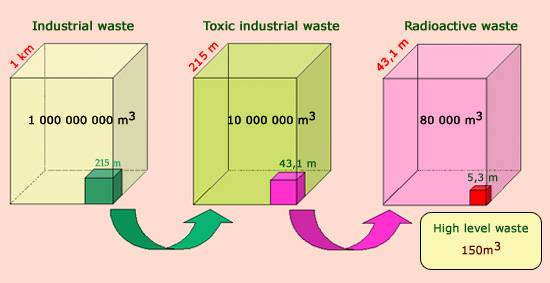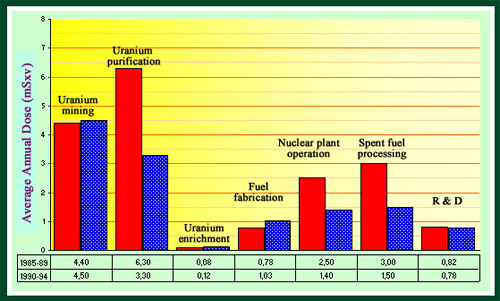Nuclear plants : Very low exposures under normal conditions
In what seems a paradox, nuclear power and reprocessing plants dealing with the most highly radioactive of elements only release minimal amounts of radiations into the environment. This apparent contradiction is due to the impressive precautions scientists, engineers and operators of these reactors take in order to preserve the environment from coming into contact with radioactive substances. Living next to one of these power plants is like living near a dam – it is theoretically possible for the dam to break, but the fact that the wall is thick and that catastrophes take place rarely means that there is little reason to worry in practice.

Fallout from civilian and military nuclear activities
Annual doses resulting from civilian and military activities have greatly decreased since the 1950’s. The graphs show the average contributions from atmospheric atomic bomb tests, nuclear reactors and the Chernobyl accident. After having reached a maximum of 0.120 millisievert (mSv) in the 1960’s, the contribution from nuclear bomb tests has dropped to a few thousandths of mSv. The three contributions combined make up less than 1% of the dose resulting from natural radioactivity, and less than the dose produced from a single scanner or X-ray radiography: providing doses received in a short airplane ride.
© IN2P3 (Source G.Gerber : analysis of UNSCEAR 2000 report)
The equivalent of the burst dam has taken place once in the history of the nuclear industry: the Chernobyl incident of 1986.
The explosion in a reactor released radioelements similar to those produced by atmospheric nuclear weapon tests. The contamination has decreased with time – with the concentrations of persistent harmful nuclei such as caesium 137 now back to their pre-Chernobyl levels – but the soil contamination (especially in heavily-wooded areas) decreases slowly and can still be felt today.

Volume of radioactive Waste
Radioactive waste represents a small volume compared to that of industrial waste. A 43 meters cube would contain all radioactive waste against a 1 km cube necessary for the industrial waste produced each year in France. For disposal of high activity waste, a 5.3 meters cube would suffice, or 1.5 ten millionth volume of industrial waste. Occupying little space, radioactive waste have no impact on the environment as long as a good conditioning, provided by the reprocessing of nuclear fuel, prevents their dispersal.
© IN2P3
Radioactive Waste : The problem of radioactive waste is very different. We know how to protect ourselves from the intense irradiation produced by the fission products and plutonium present in the spent fuel of nuclear reactors, so long as we are able to control the substances.
These radioactive waste products are not released into the environment, but are either stored in large pools or transported, processed and stockpiled at a safe distance. The efficient storage methods currently in use are primarily responsible for the low doses of radiation released from radioactive waste.
The main problem is in the long-term, with the central issue being the guarantee of a contamination-free environment for periods considerably longer than human lifespans. The least radioactive nuclei will be the last ones to decay: the risk they pose is considerably less, but they take far longer to decay.
Radioelements have also been produced for use in industry. Like with radioactive sources used in medicine, their transportation and use are subject to draconian regulations.
Scientists have also developed giant accelerators designed to explore the world of the infinitely small. The radioactivity induced by these accelerators is very small, but even these small doses need to comply with strict security measures.

Higher exposures of nuclear workers
Because of their professional activity, nuclear industry workers receive doses higher than those allowed for the public. The average doses (excluding natural radioactivity) are some millisieverts (mSv) per year. The operations of the uranium cycle which exposes the more to radiation are ore extraction and purification of uranium from ore ( « yellow cake »), through exposure to radon. The legislation requires that the dose does not exceed 50 mSv in a period of 5 years and 20 mSv in a year for exposed workers. (Report of the United Nations Scientific Committee on the Effects of Atomic Radiation.)
© IN2P3
Higher doses for workers in nuclear industry :
Personnel in industry, nuclear research and laboratories, as well as radiologists and hospital staff who are regularly exposed to radiations receive doses which often exceed the maximum levels permitted for the general public. Special legislation imposes a maximum of 50 mSv over a period of 5 years, as opposed to the rate of 1 mSv per year allowed for the public, a limit set very low. The limit does not include natural radioactivity (2,4 mSv) and the exposures from medical scans which may exceed largely 1 mSv.